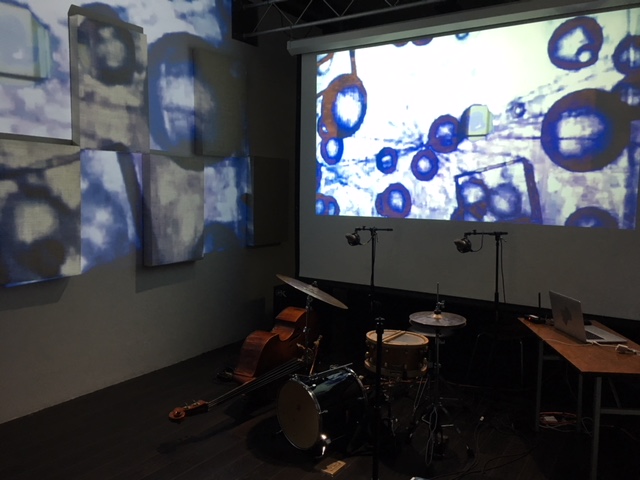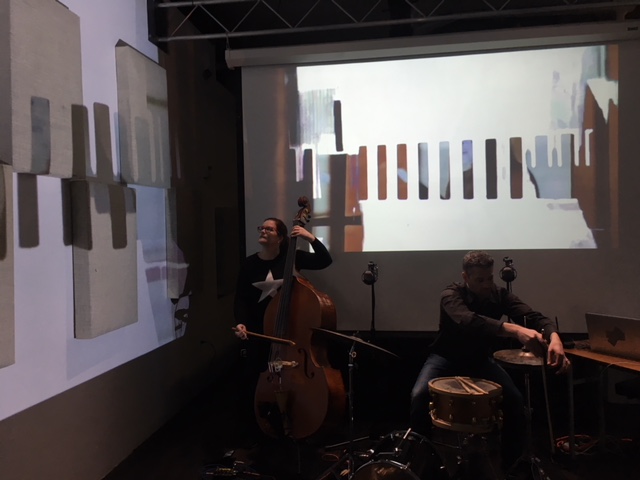

Residency Day #1: duo B. vs. viDEO sAVant at the Center for New Music
After much planning and scheduling, Ensemble in Residence, duo B. vs. viDEO sAVant finally spent its first full day at work in the Center for New Music this past weekend. Our residency this year at the Center has two goals: to develop a new evening-length work together, and to address some ongoing challenges about documentation and how best to represent our performance work to people who weren’t there in the room when it all went down.
A lot of what we hope to learn, and problems we hope to solve, this year involve our unusual identity as an intermedia ensemble of drum set, acoustic bass, and live video. Our performances are site-specific, structured improvisations that seek to create an immersive sensory environment. Charlie “sprays” his video all over every available surface, augmenting the projection surface of the screen into walls, ceilings, floors, and the rest of us players. In a live context, it can be hard to get a good acoustic balance between drum set and acoustic bass, depending on mic placement, room acoustics and also on the kind of musical material we are exploring. So up until this point, we have struggled to capture video or audio that conveys the wholeness (and frankly, awesomeness) of the live experience.
So on Saturday, we arrived with a carful of gear—three video cameras, a 360-degree camera, microphones, projectors, DI boxes, audio interfaces, laptops—to try some experiments in the space. We soon realized we probably needed even more stuff—more projectors, more video cameras, draping to close the hole between the edge of the white projection screen and the white wall, lots more SD card memory. But our initial trials were promising—close-micing the bass and drums made for a much more compelling, present and “in your face” audio experience than stereo mics out in the room alone, and working with the lighting in the room to illuminate the performers without washing out the video projection meant there were more clear images of people playing to capture in the different video camera angles. It was amazing to see how different camera heights and angles affected our perception of the projection in the recorded video samples we shot. The 360-degree video camera was a revelation, too, and we realized that we’d want to completely change how we set up in the room to take full advantage of that capability, so a viewer/listener could follow their eye/ear to where the action is at any given moment in a performance and always find something interesting to check out.
These strategies aren’t necessarily novel, but we have found they are often time prohibitive in the context of an actual performance—there is never enough time to set all the documentation so carefully while also preparing to actually play. And in the rare occasions when we can hire outside professionals to shoot video or record audio, we haven’t usually known how to coach them to capture the best footage or sound from one of our shows. So already it seems like using residency time to focus on this aspect will be a fruitful line of inquiry.
That said, now that some of these issues have been addressed, we are looking forward to our next session in the spring, when the ratio of time spent playing-to time spent problem solving will be more creatively satisfying!
Lisa, Jason & Charlie
2.24.19
Get more information about our Ensemble(s) in Residence here.